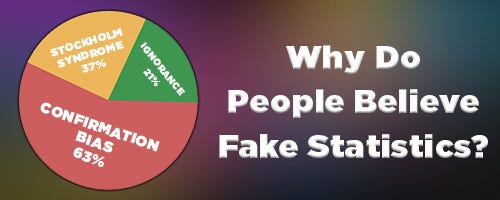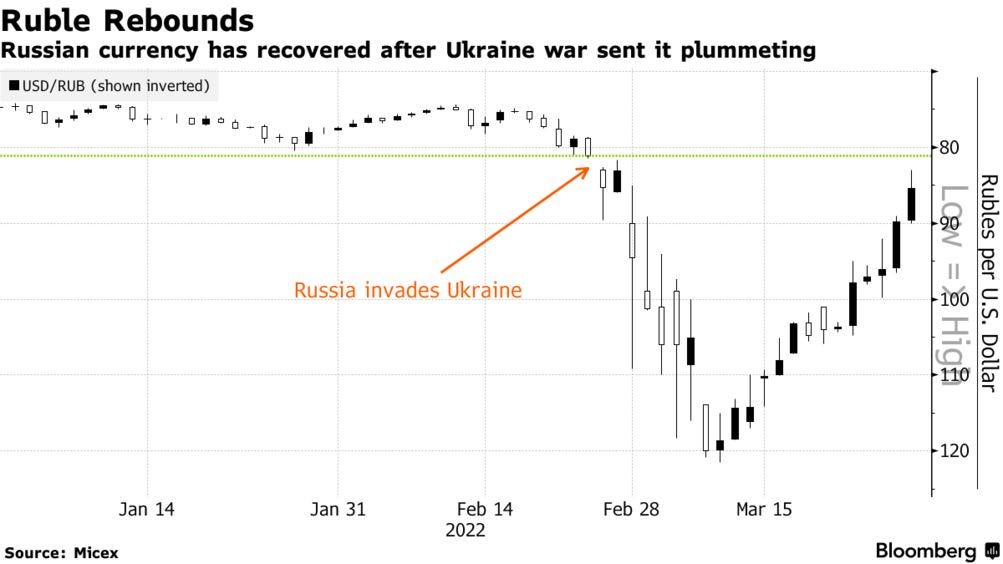Why Do People Believe Fake Statistics?
Why Do People Believe Fake Statistics?
by James Corbett
corbettreport.com
I've got a shocking piece of news for you today: Sometimes, statistics are inaccurate.
I know, I know. I've probably just shattered your world. "How can this be?" you're asking yourself.
But wait, it gets worse!
Not only are statistics occasionally inaccurate, sometimes they're presented in misleading ways!
"Say it ain't so!" I hear you screeching.
But prepare yourself; I've saved the worst for last.
Sometimes, statistics are made up.
"I can't believe it!" you say, falling on your knees as your world collapses around you.
OK, OK, enough joking around. I know you know all of this already. But today I want to talk about an interesting phenomenon related to this topic. You see, the very people who are perfectly capable of pointing out the statistical chicanery of the globalist supervillains and their MSM cronies are often the same people who fall for the statistical chicanery of people that they like.
Why is this? Let's find out.
Lying With Statistics
We all know by now that statistics, numbers, graphs and charts are routinely used by the powers-that-shouldn't-be to mislead the public, right? At the very least, those with even a passing familiarity with The Corbett Report archives will have no excuse for not knowing all about the sophomoric statistical scams that are used to convince Joe Normie of this or that globalist fraud.
There was Lies, Damned Lies and Government Statistics, where we laughed at Mark Carney's discomfort with the poor quality data emanating from the UK's Office for National Statistics and pointed out that this was not a uniquely British problem. Quite the contrary. As I demonstrated in that video, the official stats emanating from China and Japan and the US—and (needless to say) every other government—are a self-evident sham.
There was Lies, Damned Lies, and Global Warming Statistics, where we itemized the common statistical sleights of hand that are used to misrepresent data to the public (truncating the y axis, changing the units of comparison, etc.) and showed how they are employed by the purveyors of global warming pseudoscience to misrepresent climate data.
And, of course, there was Lies, Damned Lies and Coronavirus Statistics, where we were able to break down all of the basics of the COVID deception—the dodgy death data and the made up models that are now admitted even by the MSM to have been flagrant flimflam—well before basic concepts like "dying from" versus "dying with" were on the radar of Joe Q. Normie. And how were we able to be so ahead of the curve on the COVID lies? Because we've seen it all before. In fact, we're so used to this type of trickery that many of us have adapted a common sense rule of thumb: if politicians try to feed us some statistic or number in order to convince us to go along with their agenda, then they are lying to us unless specifically proven otherwise.
So, given the thorough grounding in numerical nonsense that those of us in the conspiracy reality community so obviously possess, there's no way any of us galaxy brains could ever be fooled by a duplicitous graph or a phony stat, right?
Right?
Falling for the Lies
. . . Well, hang on a second there, partner. Just because we're good at spotting the flawed figures and misleading math of those we're inclined to distrust, that doesn't mean we can't be suckered by someone we do trust. There are many examples of this that I've encountered over the years, but here's one that's popped up recently.
By now, you've probably seen the pro-Putin propaganda emanating from certain quarters of the "independent" media. You know, the propaganda that insists Putin is a 5D chessmaster who is valiantly fighting off the globalist onslaught against Russia because he loves the Russian people and is a really great guy who totally didn't consolidate his political power on the back of a false flag bombing campaign perpetrated by his FSB buddies. And you've likely heard the same pundits who swore (pre-February 24th) that Putin wasn't planning any military incursion into Ukraine opining (post-February 24th) that his military incursion into Ukraine was the most brilliant maneuver ever devised.
Yes, of course! Storm into the country with a cadre of soldiers who didn't even know about the operation until the last minute, split them up to commit a significant portion of them to a meaningless, undersupplied and—later—aborted encirclement of Kiev, and then continue the drawn-out, protracted battle for months, making minimal gains and incurring significant military losses all the while. Brilliant!
As you know, I'm not a fan of the "Putin (or Xi) versus the New World Order!" narrative(s). But one of the pieces of evidence proffered to bolster the view that this Ukraine invasion is in fact all part of Putin's grand plan to stick it to the globalists is this:
Impressive, right? I mean, you can't argue with that. It's a freakin' candlestick chart, for goodness sake! What more do you want?
To put it into words, the idea is that Putin has scored an economic coup with this military operation, provoking sanctions against Russia that have in fact benefitted the Russian economy and strengthened (or at the very least not weakened) the ruble. Or at least that's what the trustworthy folks over at The Wall Street Journal and CNN are telling us.
Now, if this were a story about how "inflation in the US is actually a good thing and you should be happy about paying $100 to fill up your car, you ungrateful peasant!" I imagine anyone not drinking the MSM Kool-Aid would be able to see through it right away. But because this is about Putin's Russia and because there are some well-meaning but deluded folk who still believe (against all evidence) that Putin is actually opposed to the globalist agenda, I might have to explain why this narrative is nonsense.
First of all, let's get one thing straight: this is a narrative. I know that candlestick chart makes it all look very mathematical and inarguable, but we have to remember that the Dow Jones index or the dollar-ruble exchange rate or the price of tea in China is just a number. In order to make any sense of that number, it has to be embedded in a narrative.
Take the "ruble rebound" narrative. It's a story that is told about how Putin's bold military adventure in Ukraine has somehow revitalized the Russian economy and firmed up the ruble's value. But never forget that at base it is just that: a story.
So the real question is this: What does the ruble-to-dollar exchange rate itself actually tell us about the state of the Russian economy?
Not much, apparently. In "What Is Behind Ruble’s Return to Pre-War Levels vs the Dollar? Massive Currency Controls" Sergey Khestanov explains that the secret to the ruble's seeming strength is that the exchange rate actually has virtually nothing to do with the economic strength of the country. In fact, currency controls prevent most Russians from actually exchanging their money at all:
Individuals are prohibited from withdrawing cash currency more than $ 10,000 until September 9, 2022.
Individuals are prohibited from exporting more than $ 10,000 in cash from the country.
Individuals could transfer abroad no more than $ 5,000 and only to close relatives. Now this limit has also been increased to $ 10,000.
The central bank has introduced a commission for the purchase of foreign currency. At first, the commission was 30%, then the Central Bank reduced it to 12%.
From March 4, legal entities also have a commission for the purchase of currency—12% of the transaction amount.
Since February 28, non-residents cannot sell their securities on the Moscow Exchange.
Since March 1, non-residents cannot transfer money from Russia abroad.
Thus, the ruble exchange rate is in reality a meaningless number for the average Russian. There are so many currency controls in place that it wouldn't matter if the rate was one ruble to the dollar or one million.
As Moscow-based journalist Riley Waggaman notes in his recent article on "Super-sanctioned Russia: Economic crisis averted?" the "strength" of the ruble is not reflected in cheaper prices for goods on the shelves of Russian stores, either. In fact, the inflation rate over there is still more than 17% (and you thought inflation in the US was bad right now).
Alright, you get the point. The idea that the incredible strength of the ruble shows that Putin's war was actually a great thing for Russia is not borne out by reality and does not reflect the actual lived experience of the average working stiff in Russia. This should not be surprising, but of course it is surprising to those who believe that Putin is truly fighting for the little guy and who are suffering from cognitive dissonance.
Please note that I am not on a high horse about this. We have all suffered from cognitive dissonance of this sort at one point or another. We have all overlooked the flaws in a statistical argument because it seems to support what we already believe. You, me and everyone else is guilty of this.
So here are the real questions: What does this mean and what can we do about it?
Why It Matters
So, what's really going on here?
On one level, it's fairly straightforward: cognitive dissonance will kick in when someone we like is using fake stats or deceptive data to support a cause we believe in. On some subconscious level, we might even feel that questioning the numbers used in defence of "our side" of an argument is tantamount to "letting down the team." It's unsurprising, then, that the tricks we can accurately identify as statistical sleights-of-hand when they are employed by our opponents are the same tricks that can fool us when they're employed by someone in our own peer group.
But if the problem really were that straightforward, then the solution would be equally straightforward: Keep your guard up and double check all stats before accepting them.
As you might have surmised by now, though, the issue is not so straightforward. In fact, upon further examination it seems that we're actually dealing with a more fundamental question: why do we so often feel drawn to back up our arguments with statistics, figures, charts and graphs in the first place? Why does Bloomberg's handy-dandy candlestick chart showing the exact curve of the ruble's rebound seem so compelling, anyway?
This is not a trivial question. As Mattias Desmet explains in his book on The Psychology of Totalitarianism, the mechanistic ideology that has gradually taken over Western thinking since the age of the Enlightenment is predicated on the idea of a rational, measurable and predictable clockwork universe. The modern mind is conditioned to expect that reality is ultimately reducible to numbers, graphs, statistics and other measurable quantities. This produces the perfect conditions for those who want to use statistics to manipulate the population.
For instance, it was this mechanistic understanding of the world that motivated the newscasts and newspapers to plaster the "scoreboard" of infections and hospitalizations all over their coverage of the COVID "crisis." As Desmet notes, only the modern mind—so utterly convinced of the inherently mathematical nature of reality—could be so terrified by this numerical talisman:
The coronavirus crisis offered an unexpected window of opportunity for the mechanistic ideology: The uncertainty and fear of the virus provided a basis for the formation and development of a society in which decisions are based on numbers rather than stories. Today, we are talking about relatively “simple” numbers on infections, hospitalizations, and deaths; in the future, we might be talking about high-tech, biometric data that precisely map every aspect of physical function.
Speaking of the future, it isn't hard to see where this mechanistic view of reality is taking us: a perfectly technocratic form of tyranny.
The universe is a machine, the components of which are measurable—that is the basic assumption of this ideology. Measurements and calculations form the basis of the mechanistic research methods. This epistemological point of departure has bearing on the ideology’s conception of the ideal society. Ideally, society is led by expert technocrats who make decisions based on objective, numerical data. With the coronavirus crisis, this utopian goal seemed very close at hand. For this reason, the coronavirus crisis is a case study par excellence in subjecting the trust in measurements and numbers to critical analysis.
In this reading, the coronavirus event was a test run of a technocratic totalitarian model, where our lives will be controlled by experts on the basis of "objective" numbers and statistics. This is not pie-in-the-sky philosophical musings; this is literally what happened in any number of places around the globe where the power to declare a health emergency—with all the restriction of movement and abrogation of bodily autonomy that implies—was legally placed in the hands of health officials who, it was assumed, can make such a determination based on the latest health data.
This is the world we are goose-stepping into: one where the statistical nonsense and made-up data of the globalists and their government/MSM/corporate lackeys is being used not just to pull a fast one on the public or to marshal support for this or that policy issue but as the basis for the technocratic control of our lives.
Who we can meet with. What job we must work. What we must or must not put in our bodies. Whether or not we can leave our homes. These are all things that the technocrats will pretend to be able to determine based on their latest numbers and calculations. And they will no doubt have the flashiest pie charts to convince the public that they are right . . . or at least to bamboozle the public into believing it's all too complicated to understand and must be "left to the experts."
So what can we do about all of this? The problem can't be easily or pithily solved in a few lines at the end of an editorial. The chain of historical, scientific and philosophical developments that have led us to this point have been taking place for centuries if not millennia, and we can no more choose to simply change the epistemological paradigm our civilization is operating under than we can choose to grow an 11th finger. As I have stressed before, the only thing that will ever actually change the world is The Revolution of the Mind—the writing of a new narrative that will allow us to reconceptualize the universe and will stop us from constantly searching for the mechanistic, technological solution to every problem we face.
In summation: yes, please do consider the statistics and numbers that are being presented to you in order to convince you of an idea, whether you agree or disagree with that idea. But, in addition, perhaps we should try going one step further and ask why we are looking for numbers, graphs and statistics to support our narratives about the world in the first place.





Comments
Post a Comment